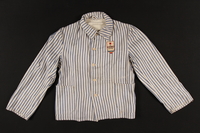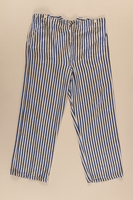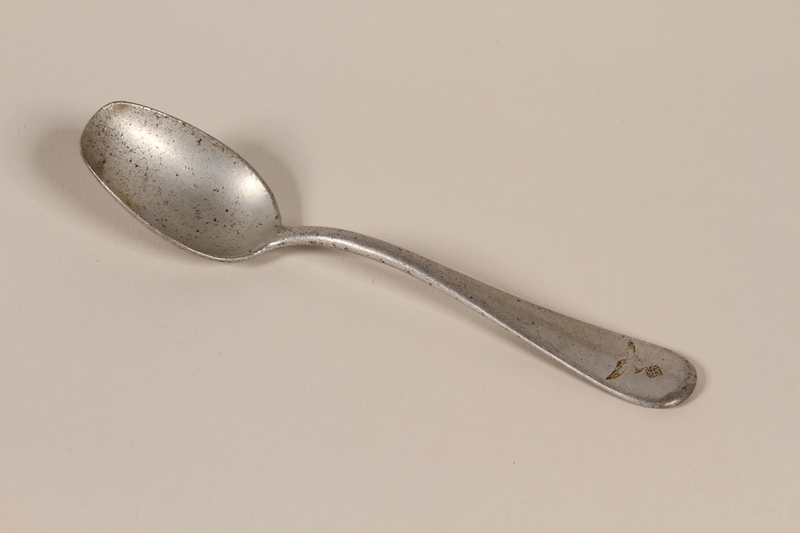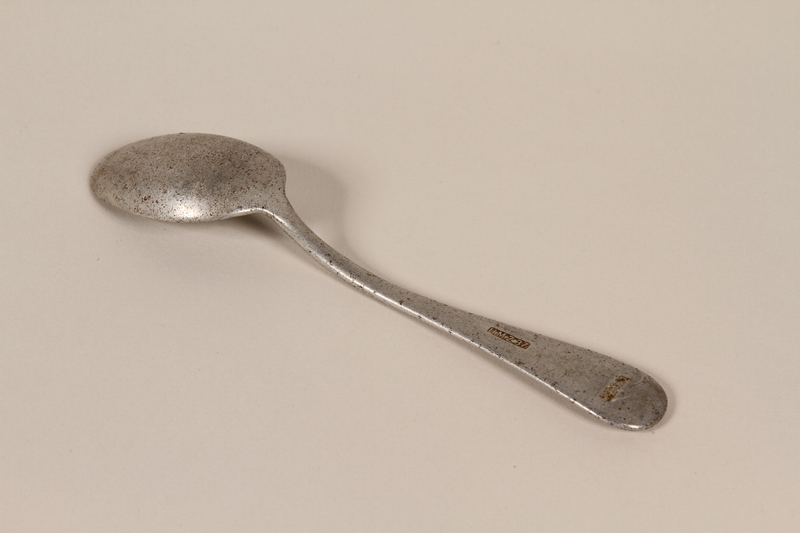Overview
- Brief Narrative
- Teaspoon with the Nazi German Luftwaffe insignia engraved on the end. The spoon was acquired by Elisabet Goldstein in 1945 while a prisoner at Salzwedel, a wire and metal goods factory that was a satellite of Neuengamme concentration camp in Germany. Elisabet was from Cluj, Romania. After the area was annexed to Hungary in 1940, Jews suffered economically and physically. Germany occupied Hungary in March 1944, and in May, Elisabet and her family, along with 18,000 other Jewish people in the area, were sent to the Kolozsvár ghetto. Within a month the ghetto was liquidated and the prisoners were transported to Auschwitz-Birkenau killing center. Elisabet’s parents were killed upon arrival and her two brothers and her husband, Isidor, were sent to Buchenwald. Elisabet was sent to several camps in Germany, including subcamps of Gross-Rosen and Neuengamme, where she was a forced laborer in various factories. She was sent to Salzwedel satellite camp only a few weeks before it was liberated by the 84th Infantry Division of the US Army on April 14, 1945. After liberation, Elisabet traveled to Buchenwald and was reunited with her brother Eugen. Her brother Josef had already been released. It is likely her husband, Isidor, perished at Buchenwald. She and her brothers eventually returned to Cluj.
- Date
-
manufacture:
1937
acquired: approximately 1945 April
- Geography
-
acquired:
Salzwedel (Concentration camp);
Saxony-Anhalt (Germany)
- Credit Line
- United States Holocaust Memorial Museum Collection, Gift of Elisabet Goldstein
- Markings
- Reverse top, engraved : NOT LEGIBLE
Reverse stem, engraved : H.M.Z. 37 - Contributor
-
Subject:
Elisabet Goldstein
Manufacturer: Arbeitsgemeinschaft Holz des Klingensthaler Bezirkes GmbH
- Biography
-
Elisabet Farkas (b.1916, later Goldstein) was born in Marosludas, Romania. Her father Henrik Farkas (1879-1944) and mother Eszther Wiegner Farkas (1889-1944) were both born in Szaszregen, Romania. Elisabet had two brothers Eugen (b.1912) and Josef (b.1913) and she was married to Isidor Goldstein. Elisabet and her family lived in Cluj, Romania where Henrik worked as a bookkeeper. Cluj had a large and flourishing Jewish community that played a significant part in the economic, social, and cultural life of the city. In August 1940, as part of the second Vienna Award, Germany forced Romania to cede northern Transylvania, which included Cluj, to Hungary. After the Hungarian annexation, Jews suffered economically and physically. In 1942, many men of military age in Cluj were conscripted for forced labor and sent to the Eastern front of the Nazi-occupied area of the Soviet Union, where most perished.
Germany occupied Hungary in March 1944. In May, the 18,000 remaining local Jews in and around Cluj, including Elisabet and her family, were sent to the Kolozsvár ghetto by local authorities and police working in cooperation with the Germans. The conditions in the makeshift ghetto were appalling. It was on the grounds of a local brickyard and consisted mostly of shacks used for drying bricks and had minimal facilities. Between May 25 and June 9, 1944, Kolozsvár Ghetto was liquidated. Six transports deported the Jewish prisoners, including Elisabet, her parents, and brothers, from the ghetto to Auschwitz concentration camp in German-occupied Poland. Her parents were taken to Auschwitz killing center and murdered shortly after arrival. In June, Eugen and Josef were both transported to Buchenwald concentration camp in Germany. Her husband Isidor was also sent to Buchenwald.
In September, Elisabet and 300 other mostly Hungarian women and children were selected by a Philips-Valvo Factory representative to perform forced labor at a plant in Weisswasser, a subcamp of Gross-Rosen concentration camp in Germany, making light globes and filaments. Upon arrival, she was issued number 26918. After heavy bombardment by the Soviet Army in February 1945, the camp was evacuated and the women were taken in wagons to Horneburg, a subcamp of Neuengamme concentration camp in Lower Saxony, Germany, to work in another Philips factory. Elisabet was given the number 11361 at Horneburg. She also worked at another Neuengamme satellite camp for women in Fallersleben, producing armaments at a Volkswagen plant. On April 8, 1945, as the Soviet Army moved closer, the Neuengamme camps were evacuated and Elisabet was sent to Salzwedel satellite camp. The camp was liberated on April 14 by the 84th Infantry Division of the US Army. Before returning to Cluj, Elisabet traveled to Buchenwald and was reunited with her brother Eugen. Her brother Josef had already been released. It is likely her husband, Isidor, perished at Buchenwald.
Physical Details
- Language
- German
- Classification
-
Household Utensils
- Category
-
Flatware
- Object Type
-
Teaspoons (Flatware) (lcsh)
- Genre/Form
- Tableware.
- Physical Description
- Silver colored, aluminum teaspoon with a flat, oval handle and a rounded end engraved on the face with a worn Luftwaffe insignia, a flying eagle clutching a swastika in its talons. The handle narrows at the stem, arches up slightly and then down into a shallow, elongated oval bowl with a flattened and worn tip. On the handle’s underside there are two hallmarks – a worn, illegible, horizontal one at the end, and a vertical one on the stem. There is black pitting on the surface.
- Dimensions
- overall: Height: 5.500 inches (13.97 cm) | Width: 1.250 inches (3.175 cm)
- Materials
- overall : metal
Rights & Restrictions
- Conditions on Access
- No restrictions on access
- Conditions on Use
- No restrictions on use
Keywords & Subjects
Administrative Notes
- Legal Status
- Permanent Collection
- Provenance
- The spoon was donated to the United States Holocaust Memorial Museum in 2002 by Elisabet Goldstein, the wife of Isidor Goldstein.
- Record last modified:
- 2023-08-25 08:19:39
- This page:
- https://collections.ushmm.org/search/catalog/irn513122
Download & Licensing
In-Person Research
- By Appointment
- Request 21 Days in Advance of Visit
- Plan a Research Visit
- Request to See This Object
Contact Us
Also in Elisabet Goldstein collection
The collection consists of a concentration camp uniform that includes a jacket with embroidered patch and pants and a teaspoon relating to the experiences of Isidor and Elisabet Farkas Goldstein in Romania, Poland, and Germany during and after the Holocaust.
Date: 1937-1946

Concentration camp uniform jacket with post liberation Buchenwald patch worn by a Romanian Jewish inmate
Object
Concentration camp uniform jacket that was worn by Isidor Goldstein, husband of Elisabet Goldstein, when he was an inmate at Buchenwald concentration camp in Germany in 1944. The jacket is made from a thin striped material sometimes referred to as “pajama stripes.” An embroidered post-liberation Buchenwald patch with the number 110099 was stitched to the breast, but has since been removed. Elisabet was from Cluj, Romania. After the area was annexed to Hungary in 1940, Jews suffered economically and physically. Germany occupied Hungary in March 1944, and in May, Elisabet and her family, along with 18,000 other Jewish people in the area, were sent to the Kolozsvár ghetto. Within a month the ghetto was liquidated and the prisoners were transported to Auschwitz-Birkenau killing center. Elisabet’s parents were killed upon arrival and her two brothers and her husband, Isidor, were sent to Buchenwald. Elisabet was sent to several camps in Germany, including subcamps of Gross-Rosen and Neuengamme, where she was a forced laborer in various factories. She was sent to Salzwedel satellite camp only a few weeks before it was liberated by the 84th Infantry Division of the US Army on April 14, 1945. Elisabet traveled to Buchenwald and was reunited with her brother Eugen. Her brother Josef had already been released. It is likely her husband, Isidor, perished at Buchenwald. She and her brothers eventually returned to Cluj.

Concentration camp uniform pants worn by a Romanian Jewish inmate at Buchenwald
Object
Concentration camp pants worn by Isidor Goldstein, husband of Elisabet Goldstein, when he was an inmate at Buchenwald concentration camp. The pants are made from a thin striped material sometimes referred to as “pajama stripes.” Elisabet was from Cluj, Romania. After the area was annexed to Hungary in 1940, Jews suffered economically and physically. Germany occupied Hungary in March 1944, and in May, Elisabet and her family, along with 18,000 other Jewish people in the area, were sent to the Kolozsvár ghetto. Within a month the ghetto was liquidated and the prisoners were transported to Auschwitz-Birkenau killing center. Elisabet’s parents were killed upon arrival and her two brothers and her husband, Isidor, were sent to Buchenwald. Elisabet was sent to several camps in Germany, including subcamps of Gross-Rosen and Neuengamme, where she was a forced laborer in various factories. She was sent to Salzwedel satellite camp only a few weeks before it was liberated by the 84th Infantry Division of the US Army on April 14, 1945. Elisabet traveled to Buchenwald and was reunited with her brother Eugen. Her brother Josef had already been released. It is likely her husband, Isidor, perished at Buchenwald. She and her brothers eventually returned to Cluj.





